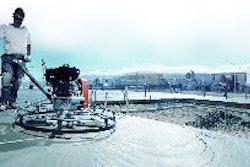
A plan to build a baseball stadium in suburban Chicago offers a case study of the pros and cons of the Obama administration's efforts to stimulate the economy.
When a proposal to build a sports complex at a community college in suburban Chicago failed, the developer did not give up. And when President Barack Obama signed the $789 billion American Reinvestment and Recovery Act, the developer saw a new opportunity.
EquityOne Sports Development, owned by Mark Houser, had already built a sports complex in Libertyville, Illinois, when Mr. Houser set his sights on McHenry County College in neighboring Crystal Lake. Still, the city council rejected the deal. At that point EquityOne Sports went a few miles down the road to Woodstock.
Under the recovery act, McHenry County has the authority to issue $27 million in low-interest bonds for private projects. Mr. Houser put a plan to the county board to issue $15 million in low-interest bonds to build a ballpark for a minor league baseball team.
''I'm not sure we can sell the bonds, but if we can, we could save some money - and the margins for this project are very narrow,'' Mr. Houser said. ''If we can't sell the bonds right away, we might sell them later.'' He estimates that lower rates could save him $5 million over 20 years on financing costs for the $18 million stadium.
The stadium offers a case study of the pros and cons of the Obama administration's efforts to stimulate the economy. Investment projects - especially for infrastructure and new technologies - produce limited, delayed results. Programs intended to keep people afloat seem to do the most to lift the economy.
Over all, the Obama program allocates $507 billion in spending programs and $282 billion in tax relief. Public works projects - including highways, bridges, schools, tunnels, museums and office parks - account for about $200 billion in spending. The package includes $115 billion for education and $87 billion for Medicaid, $50 billion for energy, $40 billion for extended unemployment benefits and $14 billion for $250 cash grants to the elderly.
The administration gives priority to ''shovel-ready'' projects like Mr. Houser's stadium. But despite the rush, public works projects can not get going fast enough to help the economy, experts say. Construction of the stadium, if approved, will begin next spring at the earliest.
Because state officials are eager to win federal stimulus money and begin work as soon as possible, less worthy projects move to the front of the line.
''There's always a big bang from infrastructure, but it takes too long to get started,'' said Bruce Bosworth, a senior fellow at the Brookings Institution. ''You can't credit infrastructure with anything. All they did this summer was minor projects, painting bridges, which they were going to do anyway.'' Federal contracts with private businesses, worth about $16 billion, have ''created or saved'' more than 30,000 jobs, according to figures released on recovery.gov, the government Web site. If that rate extended to the whole stimulus package, about 1.5 million jobs would result, at a cost of about $530,000 per job during the next two or three years. That would fall short of the administration's goal of 3.5 million jobs by the end of 2010.
Those figures raise a basic question about the best strategy for reviving the economy. Infrastructure not only puts construction workers on the job, it could also create a foundation for new waves of economic growth. Highways, airports and rail lines could increase the efficiency of local economies, and research and development could lead to innovation.
But those brick-and-mortar projects happen too slowly to counter the downturn - and may actually have negative consequences. To spread benefits and get projects moving, small projects often get priority over high-impact projects. Some projects - like light rail, a favorite of ''smart growth'' advocates - could produce long-term costs with few tangible benefits.
That is the danger with the sports complex in suburban Chicago. The earlier facility built by Mr. Houser, in Libertyville, failed to meet revenue projections, obliging the city government to use $7 million in rainy-day funds to make good the shortfall.
Mr. Houser has assured officials in Woodstock that failure would not bring a bailout. Liability for all obligations would fall on whatever bank finances the project, he said. Still, independent studies show that such sports facilities frequently need both operating and capital subsidies.
A problem with stimulus funding, experts say, is that dubious projects too often jump to the head of the line. Projects with political backing win funding, regardless of merit, while more worthwhile projects languish for decades.
''For all the talk of shovel-ready projects, I don't see rebuilding bridges and sewer systems,'' said Jeff Rosensweig, professor of international finance at Emory University's Goizueta Business School. ''We have crying needs that I hoped this money would address. But too many bad projects are moving forward.''
Clifford Winston, a senior fellow at the Brookings Institution, said the selection criteria for projects too often paid inadequate attention to economic impact considerations. ''The returns are very low for infrastructure projects,'' he said. ''The reason is they don't use cost-benefit analysis.''
Robert G. Bea, a professor of civil and environmental engineering at the University of California, Berkeley, said, ''These shovel-ready projects do a good job filling potholes, patching up the quilt.'' But, he added, ''we have a monumental mess. There's no one with a vision, and there are so many systems that could completely collapse.''
In June, Senator Tom Coburn of Oklahoma released a list of 100 ''questionable'' projects in development, valued at $5.5 billion.
Regardless of these and other projects' desirability, experts argue that real stimulus requires a strategy for long-term development.
Since the completion of the Interstate Highway System, U.S. and state governments have not developed a coherent strategy for infrastructure. The Transportation Department scrutinizes projects but still funds efforts, like Boston's Big Dig tunnel and projects for light rail, that would not pass muster on cost-benefit analyses.
Politicians embrace public works projects for symbolic as much as practical reasons, said James K. Galbraith, an economist at the University of Texas. ''Spending on infrastructure is one thing you should do,'' he said, ''but there was an excessive desire to leave a definite mark on the landscape, when you can do just as much good for the economy by keeping a teacher employed.''
Mr. Galbraith said new entities should be set up to invest in energy and environmental projects, while Mr. Bea argued for water projects which, he said, could revitalize urban and regional environments.
''You need more strategic direction over next five to ten years,'' Mr. Galbraith said. ''We ought to have institutions that can do this on a sustained basis, and not just financing of suburban sprawl or broadband.''
Still, Martin Feldstein, who served as Ronald Reagan's chief economic advisor and now sits on President Obama's Economic Recovery Advisory Board, argues that the public works projects in development will prove to be useful.
Even if it takes time to get infrastructure projects under way, he said in a paper delivered at the 2009 American Economic Association, this is less of a problem than it might seem ''because the current downturn is likely to last much longer than previous ones.''
Past recessions lasted 12 months, he said, while this one could last twice that long.
Yet even Mr. Feldstein warned that excessive delays in capital projects would make them irrelevant. He also criticized the stimulus policy for bypassing military spending, which could produce immediate jobs and drive a new generation of technological advances.
On the financial front, by injecting much-needed capital, the bailout has prevented bank failures and shored up lending. Over all, the government allocated $10 trillion to save banks, investment and insurance companies, and housing programs - of which more than $2 trillion has been disbursed.
Adding in the share of the record government deficit attributable to the bailout of the banking system, the administration's stimulus package ''had a needed positive effect,'' Mr. Rosensweig, of Emory's Goizueta Business School, said. ''It was both inefficient and unfair, but it would have been a lot worse to let the financial system collapse.''
Whatever the doubts over the utility of the infrastructure spending, and however unfair the bailout of banks and insurance companies may have been, stimulus aid to state governments has unquestionably produced immediate benefit for many thousands of people. Aid, mostly for education and Medicaid, saved many state governments from fiscal collapse, avoiding tens of thousands of teacher layoffs and maintaining services and providing cash for poor families and unemployed workers.
As many as 294,000 teachers, according to a study at the University of Washington, faced layoffs because of the fiscal crisis. But state officials report saving 62,000 teacher jobs in California, 15,000 in Michigan, 8,500 in Missouri and 2,600 in Utah.
Yet even in those cases, critics say federally funded aid for education carried a heavy price. The government issued hundreds of pages of technical regulations for using the funds. ''The reporting requirements are so huge and so vast,'' said John Musso, the executive director of the Association of School Business Officials International. ''They're really quite onerous.''
Worse, school reformers say, the stimulus money has allowed states to continue on their same path instead of reforming education and other state and local programs and services.
''The states have been reckless for years and years, increasing spending 5 or 6 percent a year,'' said Tad DeHaven, a fiscal and budget policy analyst at the conservative Cato Institute who once served as a budget official for the state of Indiana. ''This should be a time of reform, but this money staves off reforms.''
As with the building of economically unjustified sports stadiums, so with the propping up of state education systems without reforming the basic systems of teaching or school management: Only budget crises and other emergencies create the incentives that states and localities need to concentrate their minds on innovation, Mr. DeHaven said. ''Now that's gone,'' he said. ''It's a real loss.''


















